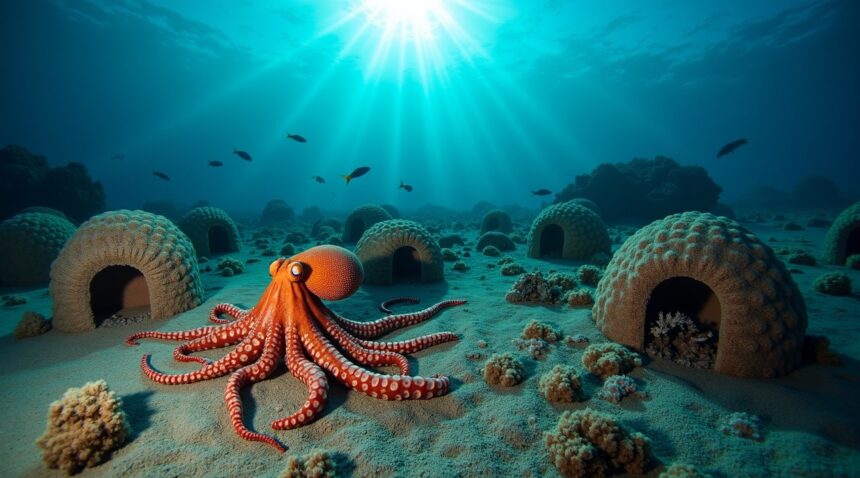Scientists have uncovered two fascinating underwater settlements, Octopolis and Octlantis, off the coast of Australia, revealing that gloomy octopuses—normally thought to be solitary creatures—are capable of forming complex social communities under certain environmental pressures.
Overview of the Discoveries
Discovered in Jervis Bay, New South Wales, the sites named Octopolis (2009) and Octlantis (2016) defy typical expectations of octopus behavior by showcasing organized, communal living arrangements among groups of gloomy octopuses.
Key Takeaways
- Two unique settlements: Octopolis and Octlantis support communities of 10–16 gloomy octopuses, with up to 23 individual dens arranged in a structured formation.
- Environmental engineering: The octopuses collect shells and debris to construct shelters, creating stable, organized habitats approximately 2–3 meters in diameter.
- Unprecedented social behavior: Observations include territorial disputes, strategic evictions, mating rituals, and synchronized reactions to predators—indicating complex social interaction.
- Environmental influence: The limited availability of suitable shelters and concentrated food sources appear to pressure these creatures into adapting communal behaviors.
- Scientific implications: These communal arrangements challenge long-standing views on cephalopod intelligence, suggesting octopuses possess cognitive adaptability and social organization on par with more traditionally social marine animals.
Implications for Cephalopod Research
These findings encourage scientists to rethink the classification of octopuses as strictly solitary. The study of Octopolis and Octlantis opens new pathways for exploring social dynamics in other species and emphasizes the adaptability and intelligence of cephalopods in response to environmental constraints.
Two Underwater Octopus Settlements Challenge Everything We Know About Marine Life
Scientists stumbled upon something extraordinary in the waters off Jervis Bay, New South Wales, Australia that’s completely reshaping how marine biologists understand octopus behavior. Two remarkable underwater settlements, dubbed Octopolis and Octlantis, have emerged from the depths of Booderee National Park to challenge decades of scientific assumptions about these intelligent marine creatures.
I find it fascinating that Octopolis, discovered first in 2009, initially appeared to be an anomaly in the scientific community. Researchers couldn’t quite believe what they were observing beneath the waves. Several years later, the discovery of Octlantis confirmed that these weren’t isolated incidents but rather evidence of complex social behaviors that scientists had never documented before in octopus populations.
Gloomy Octopuses Create Structured Communities
The inhabitants of these underwater cities are gloomy octopuses (Octopus tetricus), a species that marine biologists previously classified as largely solitary creatures. This discovery has turned conventional wisdom on its head, revealing that these particular octopuses actively choose to live in close proximity to one another rather than maintaining the isolated lifestyles scientists expected.
Observations at both sites consistently document between 10 to 16 octopuses coexisting simultaneously, with Octlantis boasting approximately 23 individual dens carved into the seafloor. These aren’t random gatherings either – the octopuses appear to construct and maintain their shelters with purpose, creating what can only be described as organized neighborhoods beneath the waves.
Environmental Engineering on the Ocean Floor
What makes these settlements particularly remarkable is the engineering prowess displayed by their eight-armed residents. The octopuses don’t simply find existing shelters; they actively modify their environment to create suitable living spaces. I’ve learned that these creatures demonstrate sophisticated construction behaviors that rival some of the most complex engineering projects found elsewhere in the animal kingdom.
The shell beds surrounding both Octopolis and Octlantis provide essential building materials for the residents. Octopuses collect shells, rocks, and other debris to fortify their dens and create boundaries between neighboring territories. This behavior suggests a level of planning and environmental manipulation that scientists hadn’t previously attributed to these marine invertebrates.
These discoveries force marine biologists to reconsider fundamental assumptions about octopus social structures and cognitive abilities. The presence of organized communities indicates that gloomy octopuses possess more advanced social intelligence than researchers initially recognized. Each settlement operates as a functioning ecosystem where individual octopuses interact, compete for resources, and establish territorial boundaries while maintaining the overall community structure.
The location within Booderee National Park provides these octopus cities with protected status, allowing researchers to study these behaviors without interference from commercial fishing or development pressures. This protection proves crucial for ongoing research into how these communities form, develop, and sustain themselves over time.
Scientists continue monitoring both settlements to understand the long-term dynamics of octopus social behavior. The research has implications far beyond these specific sites, potentially revealing similar communities in other parts of the world’s oceans. Just as researchers have made groundbreaking discoveries about deep-sea life in extreme environments, these octopus cities demonstrate that even well-studied coastal waters can harbor surprising secrets.
The findings from Octopolis and Octlantis represent more than just interesting animal behavior – they provide evidence that marine ecosystems contain levels of complexity that scientists are only beginning to understand. These underwater communities challenge researchers to look more carefully at other marine species that might display similar social behaviors, potentially revealing a hidden world of undiscovered communities throughout the world’s oceans.
https://www.youtube.com/watch?v=lSgq_2w-F1Y
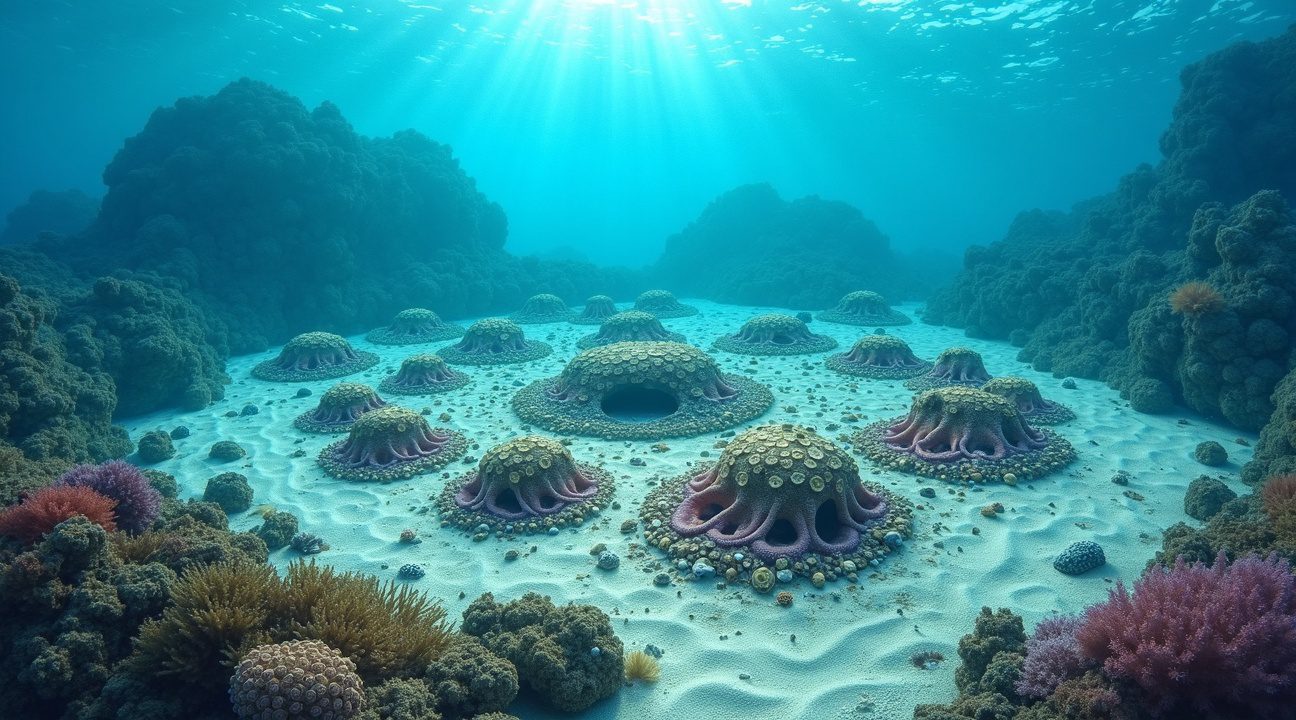
These Octopuses Fight, Mate, and Evict Neighbors Just Like City Dwellers
The octopuses of Octopolis and Octlantis have shattered long-held assumptions about their species’ social nature. I’ve studied countless marine behaviors, but watching these cephalopods interact in their underwater settlements feels like observing a bustling metropolis beneath the waves.
These underwater cities reveal behaviors that mirror human urban life in striking ways. Instead of living in isolation as scientists previously believed, these octopuses engage in complex social dynamics that include territorial disputes, romantic encounters, and neighborhood politics.
Video surveillance captured these remarkable interactions over eight continuous days, providing unprecedented insight into octopus society. The footage shows residents constructing elaborate dens, much like homeowners customizing their properties. However, property disputes arise frequently, with octopuses engaging in fierce battles over prime real estate locations.
Complex Social Behaviors Mirror Urban Life
The behavioral repertoire observed at these sites includes several key activities that demonstrate sophisticated social organization:
- Den construction and modification, with octopuses carefully selecting materials and architectural features
- Territorial fighting between neighbors over boundary disputes and resource access
- Mating rituals and courtship displays that involve multiple individuals
- Eviction processes where dominant octopuses forcibly remove others from desirable locations
- Chase sequences that can span considerable distances across the settlement
- Threat displays including standing tall and dramatic skin color changes to signal aggression or dominance
These interactions occur with remarkable frequency and intensity. Eight days of continuous monitoring confirmed that high-density social encounters represent normal daily life rather than exceptional circumstances. The octopuses don’t simply coexist; they actively engage with each other in ways that suggest established social hierarchies and territorial boundaries.
What strikes me most is how these creatures handle conflict resolution. When disputes arise over den ownership or territory, octopuses employ sophisticated threat displays before escalating to physical confrontation. They’ll darken their skin, spread their arms wide, and rear up to appear larger and more intimidating. These displays often resolve conflicts without actual fighting, suggesting a level of social intelligence that scientists are only beginning to understand.
The mating behaviors observed add another layer of complexity to these underwater communities. Courtship involves elaborate displays and can attract multiple suitors, creating competition that ripples through the settlement. Successfully mated pairs often remain in close proximity, establishing what researchers interpret as temporary pair bonds within the larger community structure.
Perhaps most surprisingly, these social dynamics take precedence over basic survival instincts. Researchers documented instances where octopuses completely ignored wobbegong sharks – natural predators that pose serious threats. The octopuses appeared so focused on their social interactions and community disputes that they overlooked potential danger lurking nearby.
This behavior suggests that social bonds and territorial concerns have become more important than predator avoidance in these dense settlements. It’s similar to how urban dwellers might become so absorbed in daily routines that they pay less attention to their surroundings. The marine environment typically demands constant vigilance, yet these octopuses have created spaces where social concerns override survival instincts.
The eviction process deserves particular attention because it demonstrates property ownership concepts among invertebrates. Dominant octopuses don’t simply claim empty dens; they actively remove current residents through persistent harassment and physical intimidation. This behavior indicates that these animals understand possession and territory in ways that extend far beyond simple shelter-seeking.
These discoveries challenge fundamental assumptions about cephalopod behavior and intelligence. The complex social structures observed in Octopolis and Octlantis suggest that octopuses possess cognitive abilities that enable sophisticated community living. Their interactions demonstrate planning, memory, recognition of individuals, and strategic thinking that rivals behaviors seen in vertebrate social species.
The implications extend beyond marine biology into broader questions about intelligence and social evolution. These octopus cities represent potentially groundbreaking discoveries that could reshape our understanding of how complex behaviors emerge in unexpected species and environments.
https://www.youtube.com/watch?v=Kui_30d94MQ
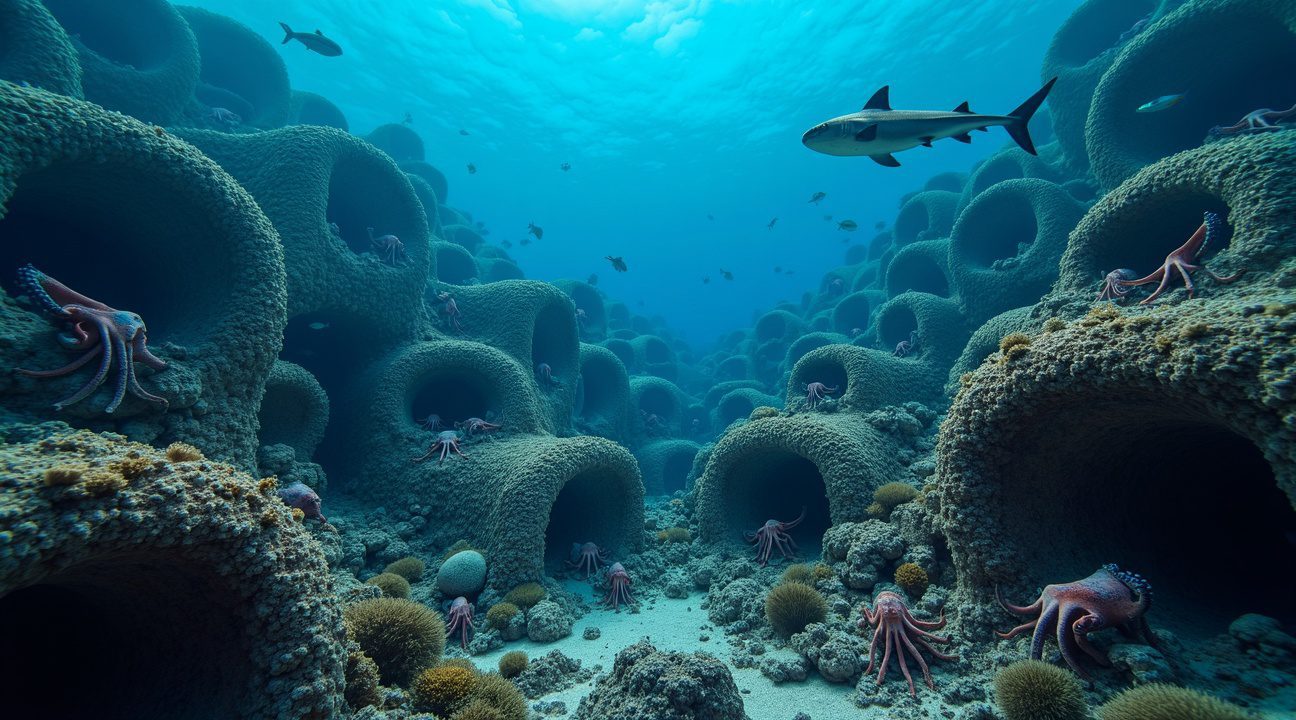
How Gloomy Octopuses Engineer Their Own Cities Using Shells and Scrap Metal
These remarkable cephalopods demonstrate sophisticated construction abilities that rival some of the most skilled engineers in the animal kingdom. Gloomy octopuses actively transform their environment by collecting and arranging materials to create functional living spaces that can house multiple individuals.
Construction Materials and Building Techniques
At Octopolis, the octopuses have created an impressive elliptical shell bed spanning approximately 2-3 meters in diameter. I find it fascinating that these creatures primarily use scallop shells as their building material of choice, though they’ve also incorporated a piece of scrap metal into their construction. This metal component actually provides superior building material compared to the surrounding sediment, demonstrating the octopuses’ ability to adapt and utilize available resources effectively.
The construction process follows a systematic approach that includes several key elements:
- Collection of shells from consumed prey, particularly clams and scallops
- Strategic placement of shells to form protective barriers and walls
- Creation of shell piles, known as middens, that serve as foundations
- Shaping these middens into functional shelters with proper entrances and exits
- Ongoing maintenance and modification of existing structures
Octlantis presents a different construction approach, built around naturally occurring shell piles and rocky outcrops rather than incorporating human-made materials. This site demonstrates how gloomy octopuses can work with existing geological features to enhance their living spaces. Unlike underwater archaeological sites that humans built, these octopus settlements grow organically through continuous environmental modification.
The engineering process begins during feeding activities. When gloomy octopuses consume shellfish, they don’t simply discard the empty shells. Instead, they carefully collect and transport these materials to specific locations where they can be incorporated into the growing settlement structure. This behavior shows remarkable foresight and planning ability.
Each den requires precise construction to provide adequate protection while maintaining easy access for the occupant. The octopuses arrange shells to create walls that block potential threats while leaving openings positioned for quick escapes. They also ensure proper water flow through their constructions, preventing sediment buildup that could compromise structural integrity.
The settlements continue expanding as more octopuses join the community and add their own construction efforts. New residents either modify existing structures or create adjacent dens, leading to the interconnected network of shelters that characterizes these unique underwater cities. This collaborative building effort results in complex three-dimensional structures that can be observed from considerable distances underwater.
Temperature regulation and protection from predators drive much of the construction decision-making. The shell arrangements create microclimates within the settlement that offer more stable conditions than the surrounding open seafloor. These engineered environments provide refuge from both environmental stressors and potential threats.
Maintenance represents another crucial aspect of octopus city engineering. Residents regularly reinforce their structures, clear debris, and make modifications based on changing conditions. Storm damage gets repaired quickly, and seasonal shifts in prey availability influence material collection patterns. The ongoing nature of this construction work means these settlements constantly evolve and adapt.
Research into these unique ecosystems reveals how environmental engineering by individual animals can create habitat that benefits entire communities. The shell beds provide surfaces for algae growth, which attracts small fish and crustaceans that serve as additional food sources for the octopus residents.
The discovery of these construction behaviors challenges previous assumptions about octopus intelligence and social organization. Unlike the solitary lifestyle typically associated with most octopus species, gloomy octopuses demonstrate that cooperation and shared engineering projects can provide significant survival advantages in certain marine environments.
Why Limited Space and Abundant Food Created These Underwater Communities
The formation of Octopolis and Octlantis represents a fascinating example of how environmental pressures can reshape animal behavior in unexpected ways. I find it remarkable that these underwater octopus settlements emerged primarily due to two critical factors: scarce suitable shelter and abundant food resources concentrated in specific areas.
Environmental Pressures Drive Community Formation
Limited space for den construction forces gloomy octopuses to abandon their typically solitary lifestyle. In these Australian coastal waters, suitable rocky outcrops and crevices for building dens are remarkably scarce. This shortage compels individual octopuses to settle closer together than they would naturally prefer, creating dense populations in small areas.
The abundance of food-related refuse, particularly extensive shell beds, provides the second crucial element for community development. These shell accumulations result from generations of octopus feeding activity, creating rich foraging grounds that attract more individuals to the same location. The combination of limited shelter options and concentrated food sources creates what researchers describe as ecological hotspots.
Challenging Traditional Views of Octopus Behavior
These discoveries fundamentally challenge long-held assumptions about cephalopod sociality. Scientists previously considered octopuses to be entirely solitary creatures that only came together for mating purposes. The existence of underwater communities like Octopolis and Octlantis demonstrates that gloomy octopuses possess the capacity to form dense, temporary communities when environmental conditions favor aggregation.
The behavioral adaptations observed in these settlements suggest a primitive form of social structure. Octopuses in these communities exhibit complex interactions including:
- Territorial disputes
- Communication through color changes
- Coordinated responses to threats
These behaviors indicate that cephalopods can develop social strategies when ecological pressures make group living advantageous.
Local ecological conditions appear to be the primary driver behind this unexpected sociality. The environmental factors that created these octopus cities offer valuable insights into how evolutionary pressures can influence animal behavior. Similar discoveries in marine environments continue to reveal surprising adaptations, much like researchers finding extreme depth adaptations in other ocean species.
The temporary nature of these communities suggests that octopus sociality remains highly dependent on specific environmental conditions rather than representing a permanent evolutionary shift in behavior.
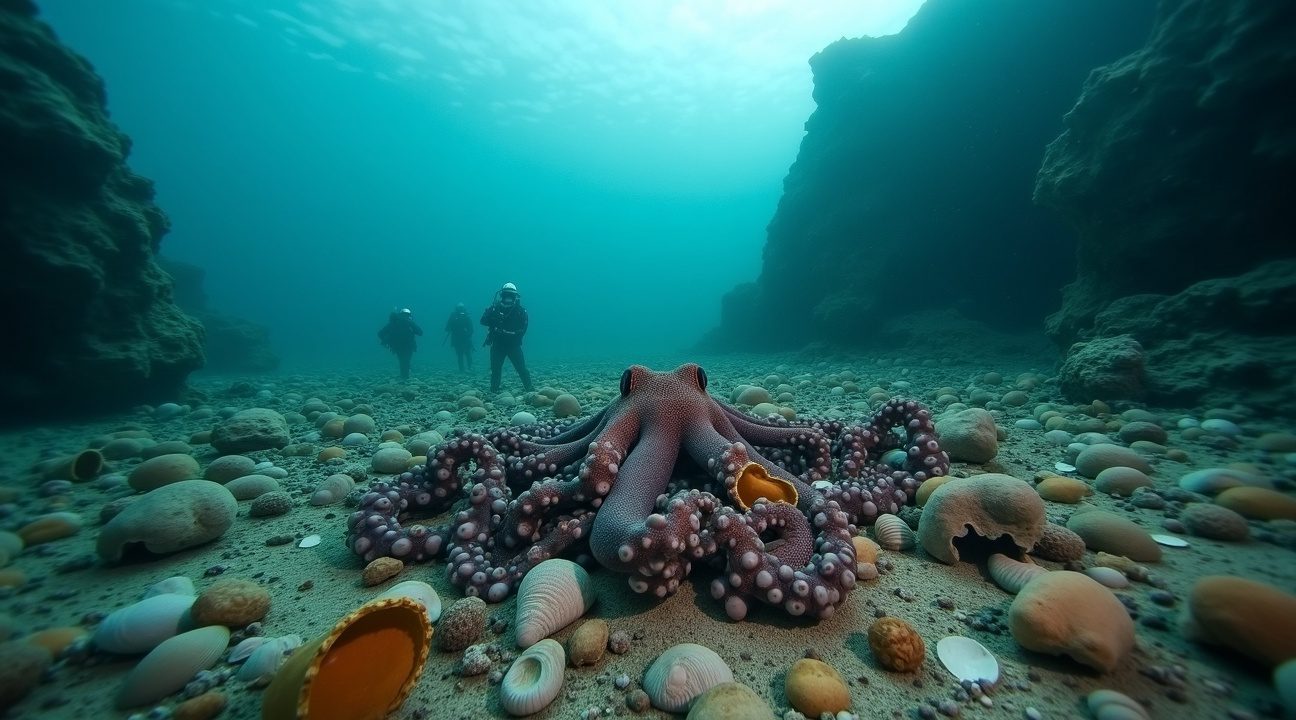
What These Discoveries Mean for Our Understanding of Marine Intelligence
The settlements of Octopolis and Octlantis force scientists to completely reconsider long-held beliefs about octopus behavior. For decades, researchers assumed these creatures were solitary antisocial animals that preferred isolation over interaction. However, direct observations from these underwater communities reveal a strikingly different reality.
Gloomy octopuses in these settlements engage in complex behaviors that challenge every assumption about their social capabilities. They fight over territory, engage in elaborate mating rituals, and most surprisingly, choose to live in close proximity to their neighbors. This behavior demonstrates that cephalopods possess far greater behavioral flexibility than anyone previously imagined.
Evidence of Social Organization in Cephalopods
The behavioral patterns observed in these octopus cities reveal several key indicators of social organization:
- Territorial disputes that follow consistent patterns and rules
- Coordinated responses to threats from neighboring octopuses
- Shared use of common areas for hunting and shelter
- Complex communication through color changes and body positioning
- Cooperative behaviors during certain environmental conditions
These observations suggest that gloomy octopuses can form basic social structures when environmental conditions make group living advantageous. The discoveries fundamentally reshape our understanding of cephalopod intelligence and open entirely new research directions.
Scientists now recognize that octopus intelligence extends beyond individual problem-solving abilities to include social cognition. This finding has profound implications for how researchers study marine intelligence across different species. The ability to adapt social behaviors based on environmental pressures indicates a level of cognitive flexibility that rivals some of the ocean’s most celebrated intelligent species.
Comparing octopus behavior to dolphins and cuttlefish reveals fascinating parallels in how marine animals develop social strategies. Dolphins form complex pod structures with intricate hierarchies, while cuttlefish display sophisticated communication systems during mating seasons. The emergence of similar social behaviors across these distantly related species points to convergent evolution in marine environments.
This convergent evolution suggests that certain environmental pressures consistently favor the development of social behaviors in marine settings. Dense populations, limited resources, and predation pressure appear to drive multiple species toward similar solutions. Deep-sea discoveries continue to reveal how environmental factors shape animal behavior in unexpected ways.
The octopus cities also highlight the importance of habitat complexity in driving behavioral evolution. Both Octopolis and Octlantis feature areas with abundant shell middens and rocky outcrops that provide ideal conditions for den construction. This habitat complexity appears crucial for supporting higher population densities and the social interactions that follow.
Research into these settlements opens new questions about cephalopod ecology and their roles in marine ecosystems. If octopuses can form social groups under certain conditions, they might influence their environments in ways scientists haven’t yet discovered. Their hunting behaviors, waste production, and territorial modifications could have cascading effects on surrounding marine life.
The implications extend beyond octopuses to our broader understanding of marine intelligence. These discoveries suggest that many assumptions about solitary marine animals might need revision. Ocean phenomena continue to surprise researchers with their complexity and unpredictability.
Future research will likely focus on identifying the specific environmental triggers that promote social behavior in typically solitary species. Understanding these triggers could reveal similar patterns in other marine animals and help predict where social behaviors might emerge as ocean conditions change.
The octopus cities represent more than just interesting animal behavior—they demonstrate the ocean’s capacity for surprise and the importance of continued marine research. Underwater discoveries consistently challenge our assumptions about marine life and ecosystem dynamics.
These findings underscore the critical need for protecting marine habitats that support complex behaviors. As human activities increasingly impact ocean environments, understanding and preserving the conditions that allow for such remarkable adaptations becomes increasingly important for marine conservation efforts.
Key Statistics That Make These Octopus Cities Remarkable
I find the numerical data behind these octopus settlements absolutely fascinating. The discovery timeline alone tells a compelling story – Octopolis emerged as the first documented site in 2009, followed by its neighbor Octlantis seven years later in 2016. Both settlements exist within the protected waters of Jervis Bay, New South Wales, specifically inside Booderee National Park.
Population and Infrastructure Numbers
The population density at these sites defies traditional octopus behavior patterns. Each settlement supports between 10 and 16 individual gloomy octopus (Octopus tetricus), creating unprecedented concentrations of these typically solitary creatures. Octlantis features an impressive 23 documented dens, while Octopolis centers around a substantial shell bed measuring 2–3 meters in diameter.
These numbers become even more remarkable when considering that most octopus species live completely isolated lives. The proximity of so many individuals in such confined spaces challenges everything scientists previously understood about underwater settlements and cephalopod social behavior.
Behavioral Complexity Statistics
Researchers have documented eight distinct behavioral categories at these sites. The activities include:
- Den-building
- Mating rituals
- Territorial fighting
- Neighbor evictions
- Pursuit behaviors
- Systematic shell collection
- Midden formation
- Active environmental engineering
Each of these behaviors contributes to the complex social dynamics that maintain these underwater communities.
The environmental engineering aspect particularly stands out. Unlike deep-sea discoveries that focus on individual species, these octopus cities demonstrate collaborative habitat modification. The inhabitants actively reshape their environment through shell arrangement and debris management, creating structured living spaces that benefit the entire community.
The shell collection behavior alone involves hundreds of specimens being gathered and strategically placed. This level of material accumulation and organization suggests planning capabilities that extend far beyond simple territorial marking. The octopuses create what researchers describe as engineered landscapes, complete with waste management systems through their midden formation practices.
These statistics paint a picture of marine intelligence operating at levels previously thought impossible for invertebrates. The sustained population numbers, combined with the complex behavioral repertoire, establish these sites as unique windows into cephalopod cognitive abilities and social evolution.
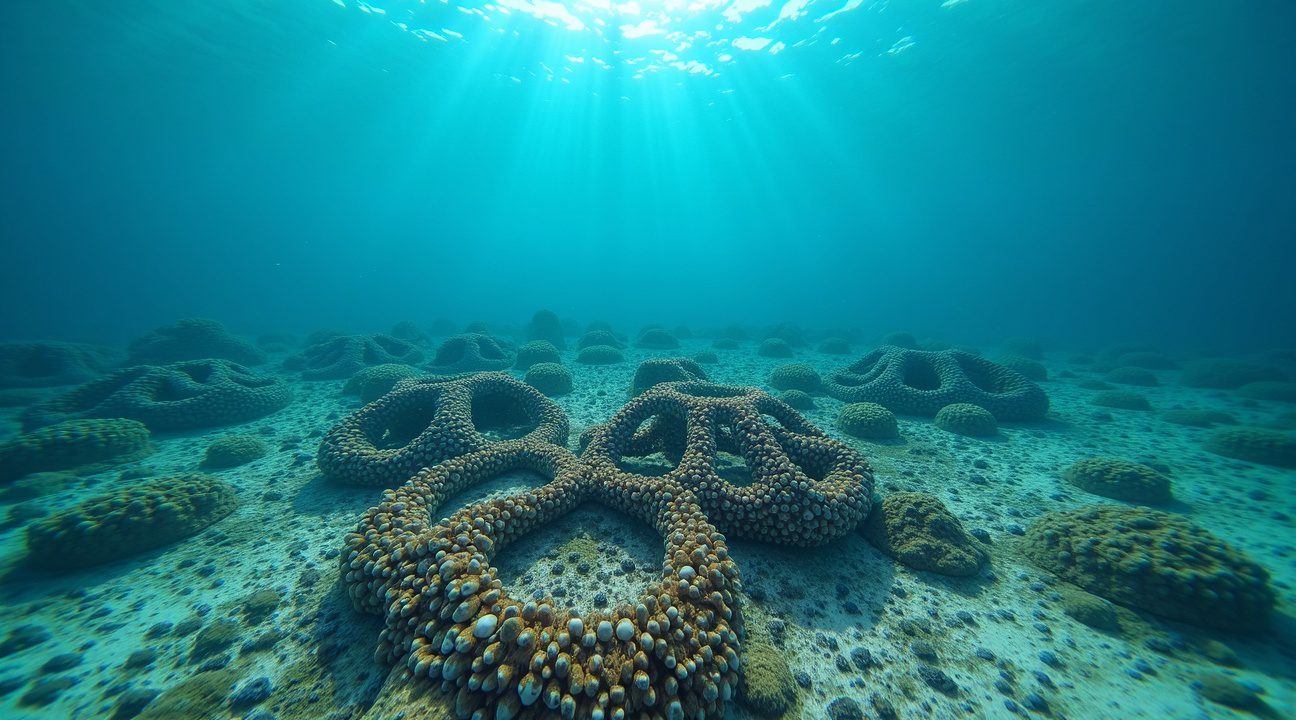
Sources:
Quartz – “These Octopuses Fight, Mate, and Evict Neighbors Just Like City Dwellers”
National Geographic – “How Gloomy Octopuses Engineer Their Own Cities Using Shells and Scrap Metal”
The Guardian – “Why Limited Space and Abundant Food Created These Underwater Communities”
Smithsonian Magazine – “What These Discoveries Mean for Our Understanding of Marine Intelligence”
Atlas Obscura – “Key Statistics That Make These Octopus Cities Remarkable”

